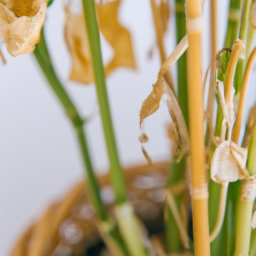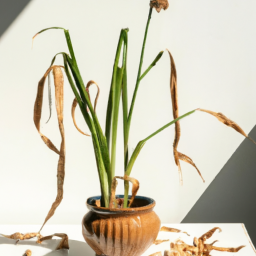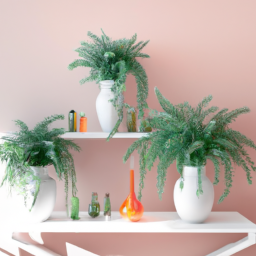
Have you ever noticed that your indoor plants are starting to look a little dry and wilted? It can be frustrating to see your beloved greenery struggling, especially when you’ve been trying your best to care for them. In this blog post, we’ll explore the reasons why indoor plants may be getting dry, and provide some tips on how to revive them and keep them thriving. So if you’re wondering “Why Indoor Plants Getting Dry,” keep reading to find out how you can help your plants flourish once again.
Why Indoor Plants Getting Dry
As an expert in indoor plants, I have encountered many cases where plant owners struggle with keeping their plants healthy and vibrant. One common issue that I often see is indoor plants getting dry. There are several reasons why this may happen, and it is important to address these issues promptly to ensure the well-being of your beloved plants.
Insufficient Watering
One of the most common reasons for indoor plants getting dry is insufficient watering. Plants need water to survive, and if they are not getting enough, they will start to wilt and dry out. It is essential to water your plants regularly, but it is also important not to overwater them. Overwatering can lead to root rot, which can be just as harmful as underwatering.
To prevent your indoor plants from getting dry due to insufficient watering, make sure to check the soil regularly. Stick your finger into the soil about an inch deep – if it feels dry, it’s time to water your plant. Different plants have different watering needs, so it’s essential to research the specific requirements of each plant you own.
Another way to ensure that your plants are getting enough water is to use a moisture meter. These handy tools can help you determine the moisture level of the soil accurately, taking the guesswork out of watering your plants. Remember, consistency is key when it comes to watering your indoor plants.
Lack of Humidity
Indoor plants thrive in environments with high humidity levels. If your home is too dry, your plants may start to dry out as well. Lack of humidity can cause the leaves of your plants to turn brown and crispy, a clear sign that they are not getting enough moisture.
To increase the humidity levels in your home and prevent your indoor plants from getting dry, consider placing a humidifier near your plants. You can also group your plants together, as they release moisture into the air through a process called transpiration. Misting your plants with water can also help increase humidity levels temporarily.
It’s essential to research the humidity requirements of the plants you own and adjust your home’s humidity levels accordingly. By providing your plants with the right amount of moisture in the air, you can prevent them from drying out and ensure that they thrive in their indoor environment.
Improper Lighting
Light is essential for the growth and health of indoor plants. If your plants are not getting enough light, they may start to dry out and become weak and leggy. Insufficient light can also cause the leaves of your plants to lose their vibrant color and eventually fall off.
To prevent your indoor plants from getting dry due to improper lighting, make sure to place them in a location where they can receive adequate sunlight. Different plants have different light requirements, so it’s essential to research the specific needs of each plant you own.
If your home doesn’t receive enough natural light, consider using artificial grow lights to supplement the light your plants receive. Position the grow lights a few inches above your plants and keep them on for 12-16 hours a day to mimic natural sunlight. By providing your plants with the right amount of light, you can prevent them from drying out and ensure that they thrive in your indoor space.

Why Indoor Plants Getting Dry
As an expert in indoor plants, I understand the frustration that comes with seeing your beloved greenery wilt and dry out. There are several reasons why indoor plants may be getting dry, and it’s important to identify the root cause in order to prevent further damage. In this article, I will delve into the common reasons why indoor plants dry out and provide you with practical solutions to keep your plants thriving.
Lack of Proper Watering
One of the most common reasons why indoor plants dry out is due to improper watering. Overwatering or underwatering can both lead to dryness in plants. It’s essential to understand the watering needs of each plant species and adjust your watering schedule accordingly. Some plants require more frequent watering, while others prefer to dry out between waterings.
In addition, the type of water you use can also impact the health of your plants. Tap water may contain chemicals or minerals that can harm your plants over time. Consider using filtered or distilled water to prevent any potential damage from occurring.
Furthermore, the size of the pot and the drainage holes can also affect the moisture levels in your plants. Make sure your pots have adequate drainage to prevent water from pooling at the bottom, which can lead to root rot and dryness.
Improper Lighting Conditions
Another factor that can contribute to indoor plants drying out is inadequate lighting. Plants need sunlight to photosynthesize and thrive. If your plants are not receiving enough light, they may struggle to absorb water and essential nutrients, leading to dryness.
Assess the lighting conditions in your home and place your plants in areas where they can receive sufficient sunlight. If natural light is limited, consider using artificial grow lights to supplement their light requirements.
It’s also important to rotate your plants regularly to ensure all parts receive adequate light exposure. This will help prevent uneven drying and promote healthy growth.
Lack of Humidity
Indoor environments can often be dry, especially during the winter months when heating systems are running. Low humidity levels can cause plants to lose moisture quickly, leading to dryness and wilting.
To combat low humidity, consider placing a humidifier near your plants or misting them regularly with water. You can also group your plants together to create a microclimate with higher humidity levels. Additionally, placing a tray of water near your plants can help increase moisture in the air.
Remember to monitor the humidity levels in your home and adjust accordingly to ensure your plants remain hydrated and healthy.

Best Practices for Watering Indoor Plants to Avoid Drying Out
As an expert in indoor plants, I understand the importance of proper watering techniques to keep your plants healthy and thriving. Many plant owners struggle with keeping their indoor plants from drying out, which can lead to wilting, yellowing leaves, and ultimately the death of the plant. In this guide, I will discuss the best practices for watering indoor plants to avoid drying out.
Understanding the Watering Needs of Indoor Plants
One of the main reasons why indoor plants dry out is because of improper watering. It is essential to understand the specific watering needs of each plant species you have in your home. Some plants require more water than others, while some prefer to dry out between waterings. Researching the watering requirements of your plants is crucial to their health.
Another factor to consider is the environment in which your plants are placed. Plants in sunny windows or near heaters will require more frequent watering than plants in low light areas. Monitoring the moisture levels in the soil is a good way to determine when your plants need water.
Overwatering can be just as harmful as underwatering, so it is important to strike a balance. Always check the soil moisture before watering and adjust your watering schedule accordingly. Remember, it is better to underwater than overwater your plants.
Proper Watering Techniques
When it comes to watering indoor plants, there are a few techniques that can help prevent your plants from drying out. The first step is to use room temperature water, as cold water can shock the roots of your plants. Water your plants thoroughly until water drains out of the bottom of the pot, ensuring that the roots are evenly moistened.
It is important to water the soil, not the leaves of your plants, as wet leaves can lead to fungal diseases. Use a watering can with a narrow spout to direct the water at the base of the plant. Avoid getting water on the foliage whenever possible.
Consider using a moisture meter to help you determine when your plants need water. These handy tools can take the guesswork out of watering and ensure that your plants are getting the right amount of moisture. Remember to adjust your watering schedule based on the season and the specific needs of your plants.
Troubleshooting Dry Indoor Plants
If you notice that your indoor plants are drying out despite your best efforts, there are a few things you can do to help revive them. Check the roots of your plants for signs of rot or dehydration, and repot them if necessary. Trim any dead or yellowing leaves to encourage new growth.
Consider increasing the humidity around your plants by placing a tray of water near them or using a humidifier. Grouping your plants together can also help create a microclimate with higher humidity levels. Remember to keep an eye on your plants and adjust your care routine as needed.
By following these best practices for watering indoor plants, you can help prevent your plants from drying out and keep them healthy and vibrant. Remember to research the specific needs of your plants, use proper watering techniques, and troubleshoot any issues that may arise. With the right care, your indoor plants will thrive and bring beauty to your home.
In a Nutshell
Have you ever noticed your indoor plants looking a little dry and wilted, despite your best efforts to keep them watered and cared for? There are a few common reasons why indoor plants may be drying out, and it’s important to understand these factors in order to help your plants thrive. One common reason for indoor plants drying out is overwatering. While it may seem counterintuitive, overwatering can actually lead to the roots becoming waterlogged and unable to absorb nutrients, causing the plant to dry out. It’s important to water your plants only when the soil is dry to the touch, and to ensure that they have proper drainage to prevent water from pooling at the bottom of the pot.
Another reason why indoor plants may be drying out is due to inadequate humidity levels. Many indoor plants, especially tropical varieties, require high humidity levels to thrive. If the air in your home is too dry, it can cause the leaves of your plants to dry out and become crispy. To combat this, you can place a humidifier near your plants, mist them regularly, or group them together to create a microclimate with higher humidity levels. By understanding these common reasons why indoor plants may be drying out, you can take steps to ensure that your plants are happy and healthy. With a little extra care and attention, you can help your indoor plants thrive and bring a touch of greenery into your home.
Your Burning Questions Answered:
Q1. Why are my indoor plants getting dry?
A1. Indoor plants can become dry due to a variety of reasons, including inadequate watering, low humidity levels, exposure to direct sunlight, or being placed near heating or cooling vents.
Q2. How often should I water my indoor plants?
A2. The frequency of watering indoor plants varies depending on the type of plant, the size of the pot, and the environmental conditions. It is important to check the soil moisture levels before watering to avoid overwatering or underwatering.
Q3. How can I prevent my indoor plants from getting dry?
A3. To prevent indoor plants from getting dry, make sure to water them regularly, provide adequate humidity levels, place them in indirect sunlight, and avoid placing them near heating or cooling sources. You can also mist the leaves or use a pebble tray to increase humidity.
Q4. What are some signs that my indoor plants are getting dry?
A4. Signs that your indoor plants are getting dry include wilting leaves, dry or crispy edges on the leaves, yellowing or browning of the leaves, and soil that feels dry to the touch. It is important to address these signs promptly to prevent further damage to the plant.
Q5. Can overwatering cause indoor plants to become dry?
A5. Yes, overwatering can lead to root rot, which can cause indoor plants to become dry and wilted. It is important to strike a balance between watering your indoor plants enough to keep them hydrated without drowning them in water.
Dr. Olivia Green is a botanist with over two decades of experience in indoor plant cultivation. She holds a Ph.D. in Plant Biology and has dedicated her career to researching plant behavior in controlled environments. Dr. Green is passionate about helping plant enthusiasts master the art of indoor gardening through her extensive knowledge and practical insights.


